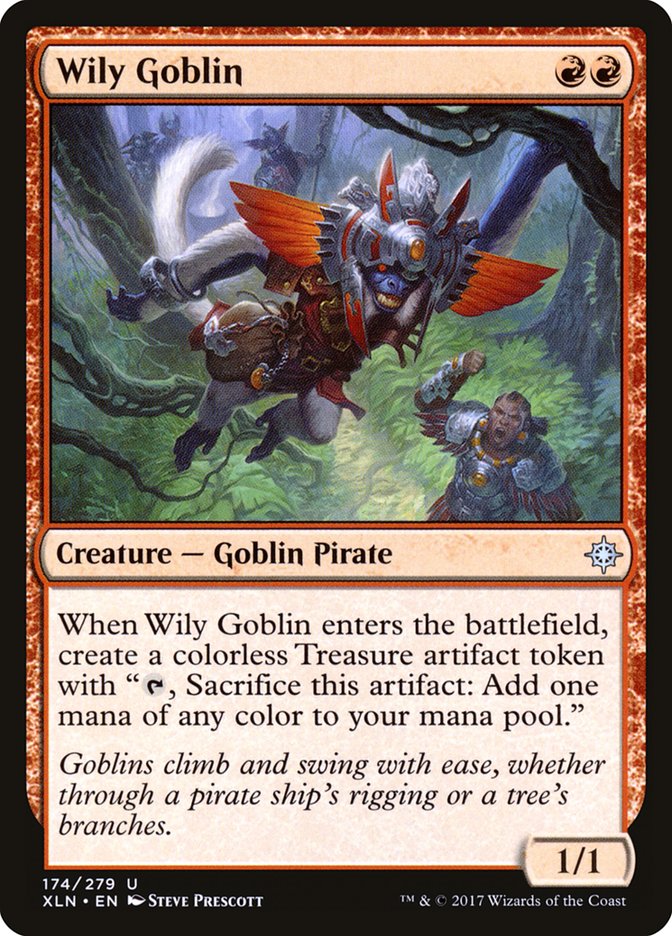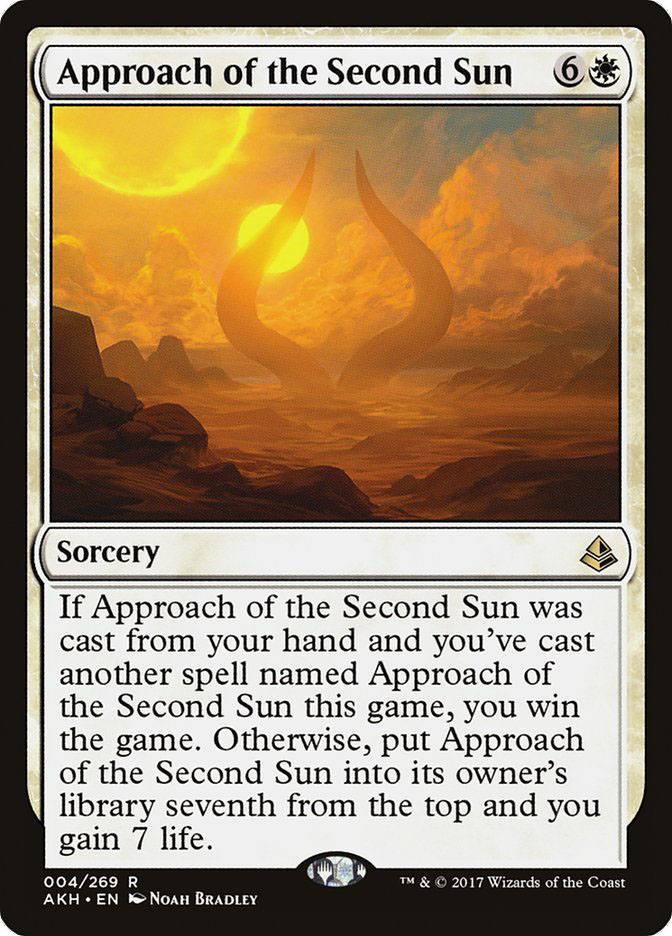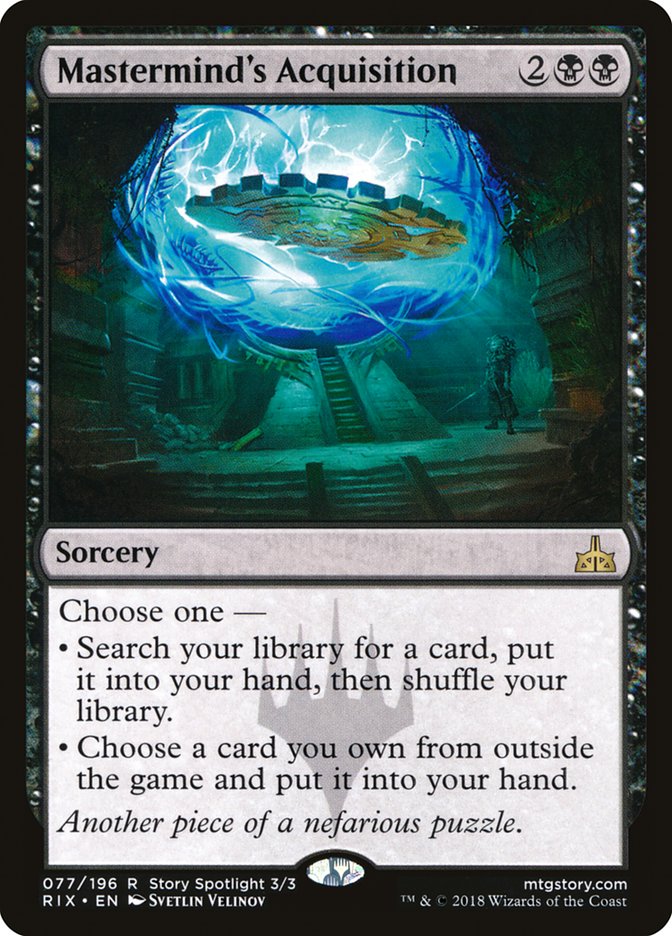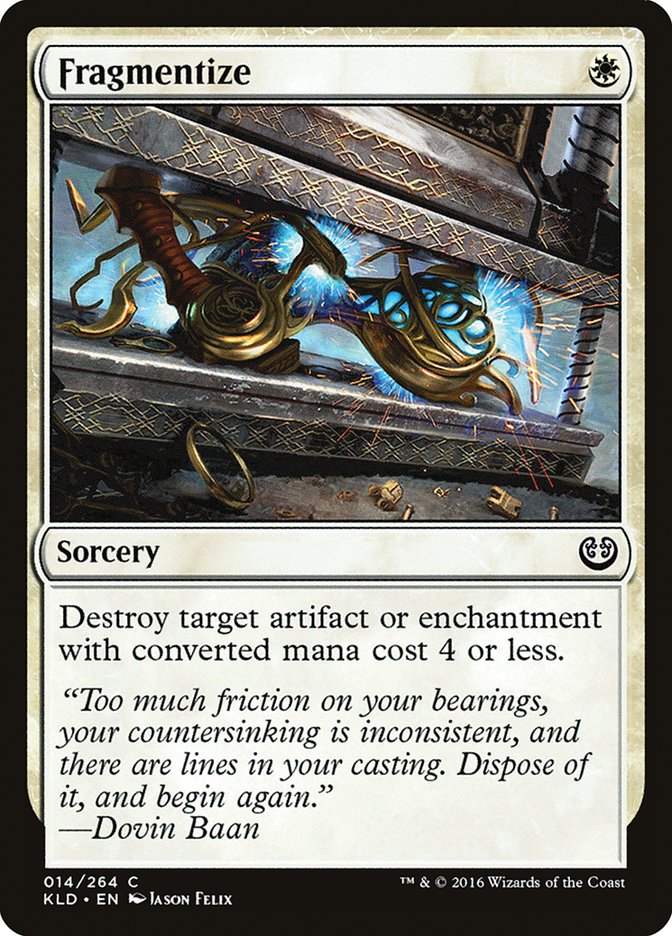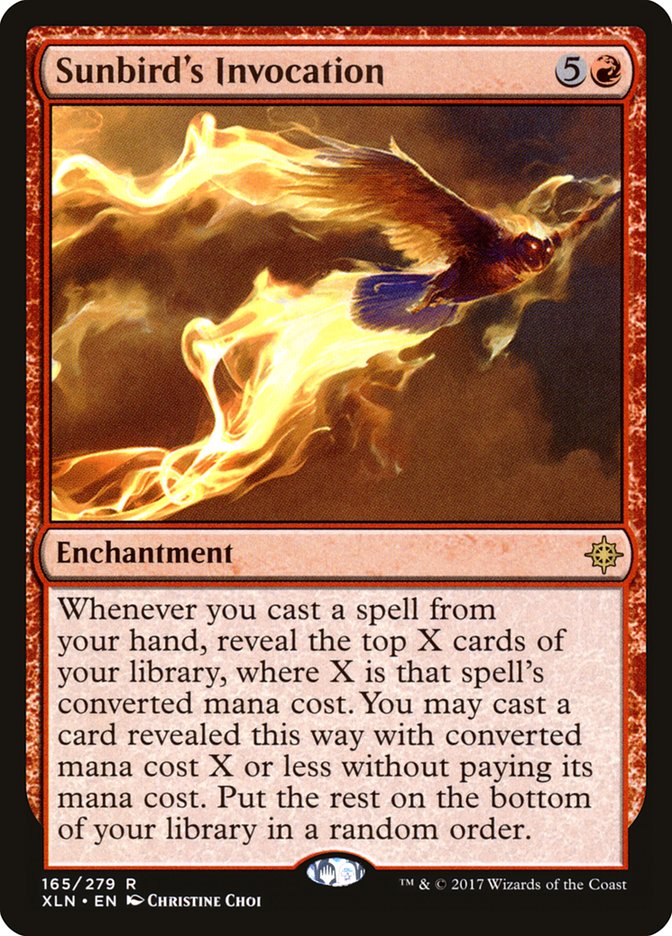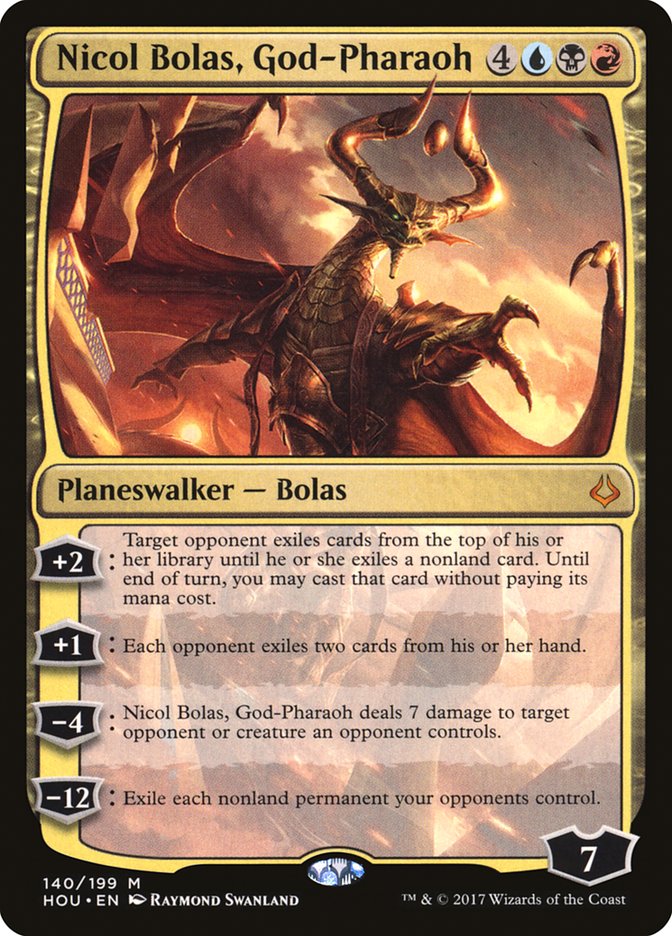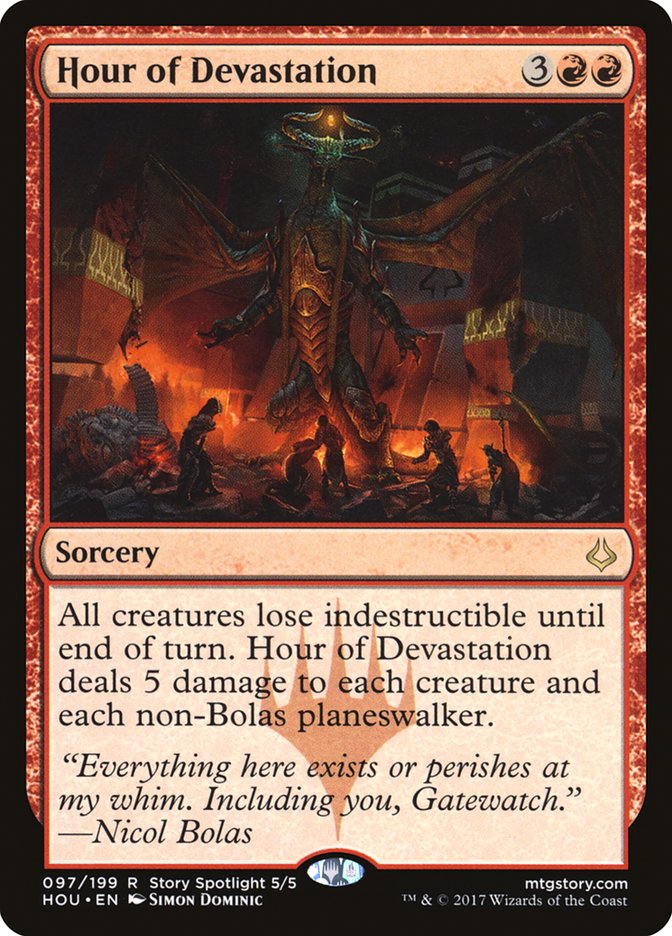Standard is pretty weird right now. The format basically seems to be
Mono-Red Aggro and a sea of midrange decks. A few people try to play
control, but I think that’s really hard to do against the combined
pressures of Red’s aggression and the wide range of different forms of card
advantage built into the midrange decks, and especially the cheap transform
cards that anyone can play, like Treasure Map. In a format like this, I
know two things:
First: I don’t want to play stock Mono-Red. I’ve had to do it before and
it’s gone well, but it’s always a last resort. I’ve never really liked
playing red aggressive decks, and I’m certainly least excited when
everyone’s doing it. If I had some kind of edge, I’d be a lot more willing
to do it though. Toward that end, here’s my one shot:
Creatures (25)
- 2 Pia Nalaar
- 4 Bomat Courier
- 3 Glorybringer
- 3 Soul-Scar Mage
- 4 Earthshaker Khenra
- 1 Captain Lannery Storm
- 4 Wily Goblin
- 4 Rekindling Phoenix
Planeswalkers (3)
Lands (23)
Spells (9)

Hazoret the Fervent is the best card in the mirror, so removing it from the
deck to try to get an edge is at least a little questionable, but
Rekindling Phoenix is also great in the mirror where there isn’t a single
card that cleanly answers it. Once you’ve decided to play Rekindling
Phoenix, you can either have a curve that’s too high for Hazoret to be at
its best and play it anyway, or you can drop it and play the other good
four and five mana spells: Chandra, Torch of Defiance and Glorybringer.
What I like about eschewing Hazoret is that if we play Chandra, Torch of
Defiance and Rekindling Phoenix, we can usefully ramp them out on turn 3
with Wily Goblin. Both of these threats are awesome if you can play them a
turn early, while Hazoret has no interest in coming down early because
you’ll still have too many cards in your hand.
Why am I excited about Wily Goblin? Look, I’m trying to get an edge in the
mirror. Consider
Ari’s claims
about the format in general and Mono-Red in particular–
“None of the two- or three-drops in the format really comes close to
competing with the four- and five-drops on impact. More importantly,
even in the aggressive shells you aren’t reliably fast enough for it to
matter. Sometimes your Bomat Couriers and Earthshaker Khenras steal games, but just as often your opponent matches you up the curve
due to a lost die roll or a slight hand mismatch.
Your two- and three-drops are simply tools for getting you to a
profitable situation for your four- and five-drops to win the game.”
If these cards are just here to facilitate my four- and five-drops, why not
play the one that literally does that? Wily Goblin can still trade with
Bomat Courier or Earthshaker Khenra, and even more importantly, it still
crews Aethersphere Harvester, but what it’s really there for is to allow
you to make a game-winning play, like Chandra, Torch of Defiance or
Rekindling Phoenix on turn 3.
Opposing Hazorets are still a problem if you’re behind, but this deck can
win the race with fliers while chump blocking with Wily Goblin even when
you can’t just combine Soul-Scar Mage and a removal spell to answer it
cleanly.
The sideboard is a little unusual, but I like where it’s at. This deck
isn’t trying to burn anyone out – I don’t have Shock or Lightning Strike –
as this is a midrange deck that’s looking to win with creatures. My
sideboard contains removal spells that are specifically designed to let me
beat other red decks regardless of whether they try to go big or not in
Chandra’s Defeat and Harnessed Lighting (which can kill Glorybringer thanks
to my use of Aether Hub and Aethersphere Harvester, or can kill a small
creature while preparing to let me gain more life with Aethersphere
Harvester later), or to become bigger and more resilient with more threats
and Treasure Maps against people who are focused on answering my threats.
Secondly, I don’t want to enter the midrange slugfest. This is the best
argument against playing the deck I just proposed even if the theory turns
out to be sound. I mentioned that I never want to play Mono-Red, but I have
an even stronger preference against playing a bunch of 2-5 mana creatures
and removal spells in a 2-3 color pile of good cards. At least Mono-Red has
a focused enough game plan that I can pretend my cards have some amount of
synergy that lets them function as something greater than the sum of their
parts.
What I really want to do in this format is just go over the top of these
midrange decks. The good news is that I think this is remarkably easy to
do. The bad news is that finding a way to beat the red decks while doing it
isn’t trivial.
The best plan that I’ve found for going over the top of the midrange decks
is simply casting Approach of the Second Sun. Ari claims that this is an
effective strategy in game 1, and that the sideboard games are extremely
difficult, and to some extent, I agree with that, but I’m more optimistic
about dodging that issue through transformative sideboarding than he is.
My starting point was R/W Approach, inspired by
Rizer’s deck
, but several things about this deck don’t make sense to me, so I changed
it around a bit and ended up here:
Planeswalkers (4)
Lands (25)
Spells (31)
- 4 Magma Spray
- 4 Cast Out
- 4 Approach of the Second Sun
- 4 Sweltering Suns
- 4 Abrade
- 1 Sunbird's Invocation
- 2 Settle the Wreckage
- 3 Treasure Map
- 1 Ixalan's Binding
- 2 Thaumatic Compass
- 2 Azor's Gateway
Sideboard

Basic changes:
-
Silent Gravestone seems like nonsense to me when you already have
Scavenger Grounds and most of your removal exiles, so I cut them all.
Renewed Faith also just feels like a placeholder. -
I like the plan of sideboarding in a bunch of creatures, but I don’t know
why I’d play Angel of Sanctions and Combustible Gearhulk over more proven
winners like Glorybringer and Rekindling Phoenix. - I like the use of cheap transform artifacts to find our cards
that matter and avoid flooding out with all of our one for ones, but I
think Treasure Map is better than Azor’s Gateway, especially in large
numbers, given Azor’s Gateway’s legendary status.
That left me here. The exact same ideas, just some card selections that I
think are direct improvements, but I’m not certain of that.
Playing this deck, I like it, but I’m not sure it’s the best way to do what
it’s doing. I’m also a little dubious about Cast Out and Ixalan’s Binding,
particularly because I don’t want my entire game to fall apart when my
opponent casts Vraska, Relic Seeker.
This lead me to wonder if black is better than white. In general, I’ve
preferred black removal in this format. I get that the whole point is that
I want to cast Approach of the Second Sun, but I don’t know that you need
to be a white deck to do that.
Here’s a direct translation of the deck to R/B additions:
Planeswalkers (4)
Lands (26)
Spells (30)

What I like about this:
-
Canyon Slough is much better than Stone Quarry. This allows me to play more
lands while flooding less, which allows me to play white as a third color
while arguably increasing my consistency overall. -
Vraska’s Contempt is better than Cast Out. These cards are really
comparable. Cast Out only requires a single colored mana, can exile
enchantments and artifacts, and can cycle. On paper, that kind of sounds
better than gaining two life, but gaining two life is a big deal, and as I
mentioned, I really hate when my removal is vulnerable to my opponent’s
removal. - Gonti, Lord of Luxury is better than Regal Caracal. I love Gonti.
It’s one of my favorite cards and among the most fun you can have in any
format. It also happens to be precisely the right kind of threat for a deck
like this that’s good at taking control, but it needs to avoid flooding out
and needs to diversify its threats to prepare for Lost Legacy to sideboard
into.
The biggest problem with this change is that I think Unlicensed
Disintegration may be a substantial downgrade from Settle the Wreckage. I
like the curve more with another three-mana removal spell, and we have
artifacts to get the three damage, but three damage doesn’t really do
anything in this deck if it isn’t hitting a planeswalker, and exiling is
really important. On top of that, we’ve traded a potential sweeper for a
spot removal spell, and that’s not always something you can afford to do.
The good news is that we still have four Sweltering Suns, so I’m not sure
it can’t work.
The big question for me is whether this deck can be further improved with
another big shift. Mastermind’s Acquisition has been showing up in a
variety of decks, and I wonder if it’s still underplayed. It occurs to me
that it’s a great way to Approach–you’ll generally have time to cast
Mastermind’s Acquisition before you need to Approach, and it means you
don’t have to have a seven mana spell that sometimes doesn’t do anything in
your deck. Maybe we’re better off if we basically just replace Approaches
with Mastermind’s Acquisition:
Planeswalkers (4)
Lands (26)
Spells (30)

I made a few other changes here:
I replaced an Unlicensed Disintegration with a Fatal Push – this might be
better anyway – but I think it’s really important to have one mana answers
to find with Mastermind’s Acquisition in case you need to turn it into a
five mana removal spell (the ability to get Fragmentize from the sideboard
is one of my favorite things about Mastermind’s Acquisition).
I dropped Sunbird’s Invocation. I’m not really sure how good that card is
to begin with, and when you can’t spike an Approach of the Second Sun off
an Approach of the Second Sun, it loses a lot of its appeal.
I said I’d be replacing Approach of the Second Sun with Mastermind’s
Acquisition, but I still have one in the maindeck. The reason is that I
want two of them so that I can use Mastermind’s Acquisition in advance to
prepare to cast them on back to back turns, and given that, I’d rather not
have two in the sideboard. This means that when I draw one naturally, I can
search for the other from the sideboard; and when I don’t, I can decide if
I want to try to win with Approach of the Second Sun or go another way.
I added a couple Drowned Catacombs, which combine with Treasure Map to
allow me to include a Nicol Bolas, God-Pharaoh in the sideboard that I can
find as an alternate end game. Nicol Bolas and Approach are ideal in very
different situations, and I think there’s a lot to be gained by having the
flexibility here.
Finally, I added an Hour of Devastation to the sideboard because it’s a
great option to have with Mastermind’s Acquisition.
Another big thing I love about moving in this direction is that it offers
another level of resistance to Lost Legacy. They probably have to name
Mastermind’s Acquisition, but then there’s still an Approach of the Second
Sun in my deck on top of the Gonti, Lord of Luxury and Glorybringers I’ll
have brought in.
Finally, there’s another Approach deck I’ve been thinking about: Abzan.
Lands (27)
Spells (33)
- 1 Fumigate
- 1 Battle at the Bridge
- 4 Fatal Push
- 2 Approach of the Second Sun
- 3 Hour of Promise
- 4 Vraska's Contempt
- 1 Settle the Wreckage
- 4 Treasure Map
- 1 Ixalan's Binding
- 1 Thaumatic Compass
- 1 The Immortal Sun
- 1 Azor's Gateway
- 1 Baffling End
- 1 Profane Procession
- 2 Moment of Craving
- 2 Mastermind's Acquisition
- 3 Orazca Relic

This deck also features the core of transform artifacts and removal spells,
but now I’m using black removal as my base, including a heavier white
splash to give myself some sweepers, and splashing green for Hour of
Promise, which lets me get to the point where I can use Mastermind’s
Acquisition and Approach of the Second Sun faster. I’ve also added Orazca
Relic to get to Hour of Promise faster. (Incidentally, I think Orazca Relic
is probably somewhat underrated. It’s no Mind Stone, but for the modern
era, this is the Mind Stone we get, and a ramp spell that cashes in for a
card and some life when we have enough mana is pretty nice.)
The manabase for this deck is really tricky. I’m splashing for fixing, kind
of, and I need basic lands and Deserts, and there are a ton of colorless
lands that are really appealing. Arch of Orazca is the most important, but
given that I want a high land count and a bunch of Deserts, other cycling
lands, and Evolving Wilds, Hostile Desert is really at its best. I also
want Field of Ruin and Scavenger Grounds as bullets for my Hour of Promise
to find. I think I’ve found a mix that works here, but it might be a little
off.
I have a few cute powerful cards to find, like Profane Procession and The
Immortal Sun. I really like what both of those cards are doing in this
deck, but I worry that I might be working too hard to beat midrange decks
more than I need to, and I’d be better off with more copies of Baffling End
or Moment of Craving instead, and that I need to just trust Mastermind’s
Acquisition, Hour of Promise, and Approach of the Second Sun to win
whenever I can live to the mid game.
As a side note, green adds a couple really nice bullets to the sideboard in
Vraska, Relic Seeker and Wildest Dreams.
I still have a lot of time left to test for Grand Prix Memphis, but these
are the decks I plan to be working on, and I hope to show up with some of
the strategies I’ve written about here.


